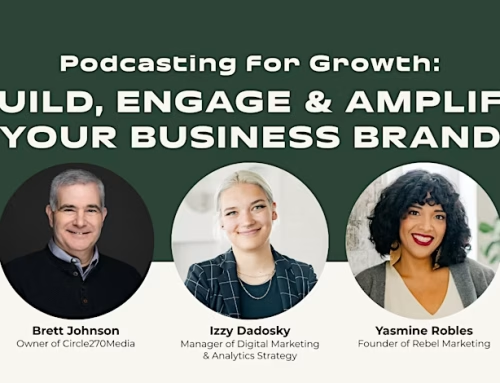Learn how to tweak your podcast website for better listener engagement and growth by fixing common pitfalls.
It could be costing you precious listeners!
Your podcast website acts as the digital home for your show. It’s often the first touchpoint for your audience. It has the power to convert casual browsers into dedicated listeners.
However, there are crucial website mistakes podcasters often make that can deter potential listeners and harm your show’s growth.
In a recent episode of “The Circle Sessions” podcast, Brett Johnson, My Podcast Guy from Circle 270 Media Podcast Consultants, spotlights five specific website flaws with experts Yasmine Robles and Izzy Dadosky from Rebel Marketing.
Here’s a breakdown of these 5 podcast website mistakes and how to avoid them.
Unclear Messaging: Speak Your Audience’s Language
The first mistake podcasters make is having unclear messaging. According to Yasmine Robles, clear and consistent messaging across your website is as vital as a visual brand guide. Your messaging should address your audience’s problems in their language, meeting them where they are.
Robles illustrates this with a personal trainer analogy: the pitch that works for one person might not work for another. It’s about knowing what resonates with your audience—whether it’s a more energized lifestyle or fitting into those snug jeans.
Crafting a messaging guide that outlines your podcast’s personality, target audience, and key messages can help create effective website copy and content for all digital platforms.
The Perils of Slow Load Times
Izzy Dadosky stresses the importance of quick load times. If your website doesn’t load in one or two seconds, you risk losing impatient visitors. Common culprits include large image files, inefficient plugins, and embedded videos that aren’t optimized for quick loading.
This is an opportunity for a website inventory check. Evaluate whether all the images and videos on your site serve a purpose. Ensure they are optimized for fast loading without compromising quality.
In digital interactions, every second counts, and slow load times can severely impact your site’s effectiveness.
Mobile Experience: Design for the Mobile-First World
With more podcast listeners accessing websites through their mobile devices, ensuring a positive mobile experience is non-negotiable. Robles emphasizes the need for mobile-first design, reflecting how users increasingly engage with content via their phones.
Whether you’re meeting someone new or a potential listener is browsing on the go, a mobile-friendly website keeps your audience engaged.
Key considerations include avoiding graphics with embedded text, which can render poorly on small screens, and ensuring your site naturally reorganizes content for mobile viewing.
Additionally, monitor your site’s performance on various mobile networks and devices to ensure a seamless experience for all users.
Don’t Forget Your Calls-to-Action (CTAs)
Effective calls-to-action are crucial in guiding your listeners on what steps to take next. Dadosky recommends making CTAs prominent and straightforward.
Whether it’s button placements on a website or links in email communications, CTAs should be visible and accessible.
A popular trend is integrating booking calendars. This allows potential guests or collaborators to easily pick a time to communicate. This eliminates the back-and-forth of scheduling via emails, making the process smooth and efficient.
Refresh Outdated Designs Regularly
Design trends evolve, and so should your website. While continual overhauls aren’t necessary, periodic refreshes can enhance your site’s aesthetic and functionality.
Robles suggests annual audits to check if design elements like images or color palettes remain current.
It’s also crucial to look beyond direct competition for design inspiration. Analyze successful sites across different industries for ideas that resonate with your brand and audience.
Outdated designs can signal that other areas of your podcast might be outdated too, deterring potential listeners.
Your Podcast Website is Your Castle
Your podcast website should be a dynamic extension of your podcast, rather than a static accessory. By addressing unclear messaging, optimizing for speed and mobile, making CTAs effective, and regularly updating your design, you create an inviting online presence that appeals to new and existing listeners alike.
Remember, a well-maintained website amplifies your podcast’s mission, helping you engage more effectively with your audience.
For further insights into optimizing your podcast website, listen to the full episode of “The Circle Sessions,” available on your favorite podcast player.





